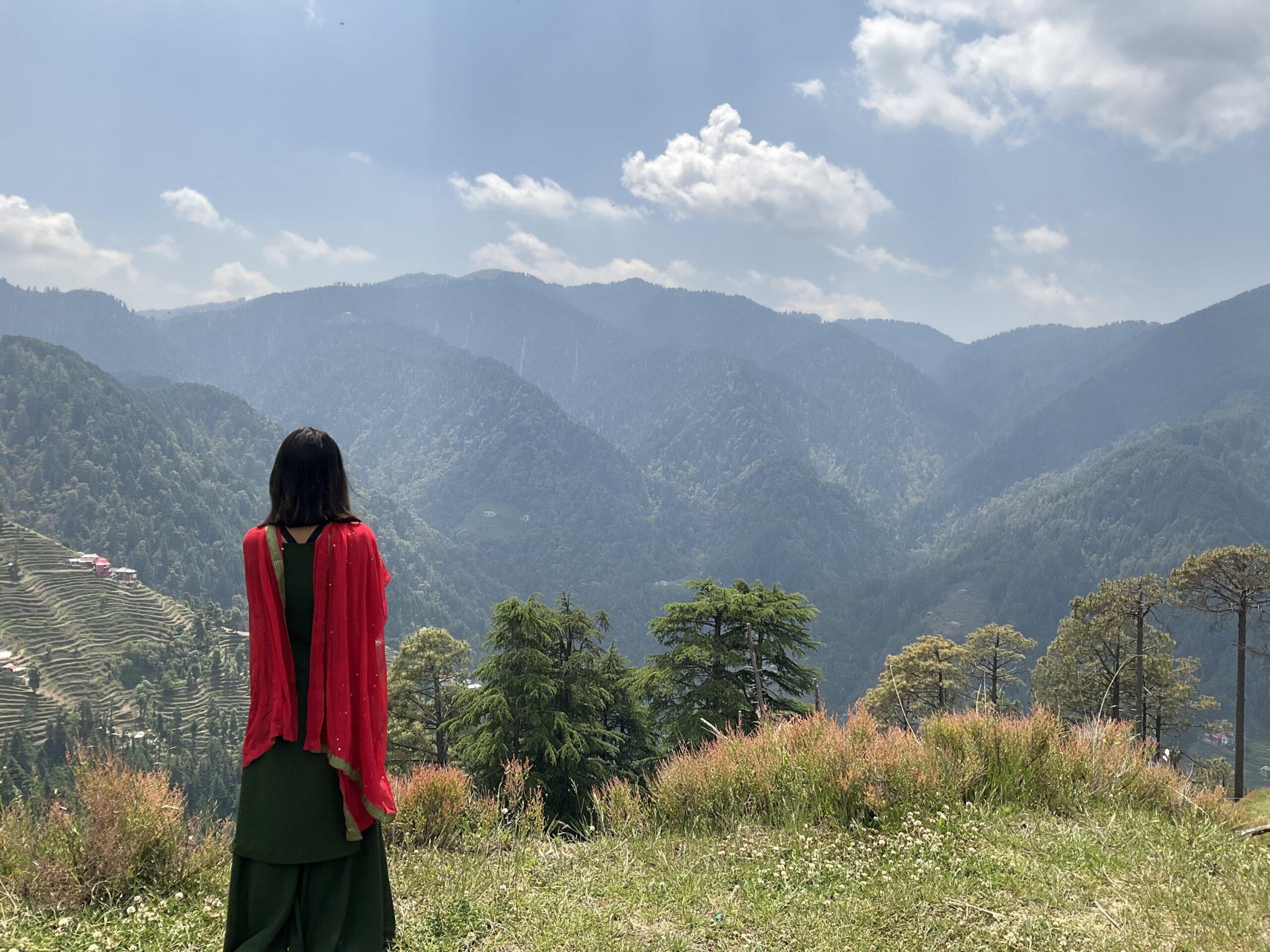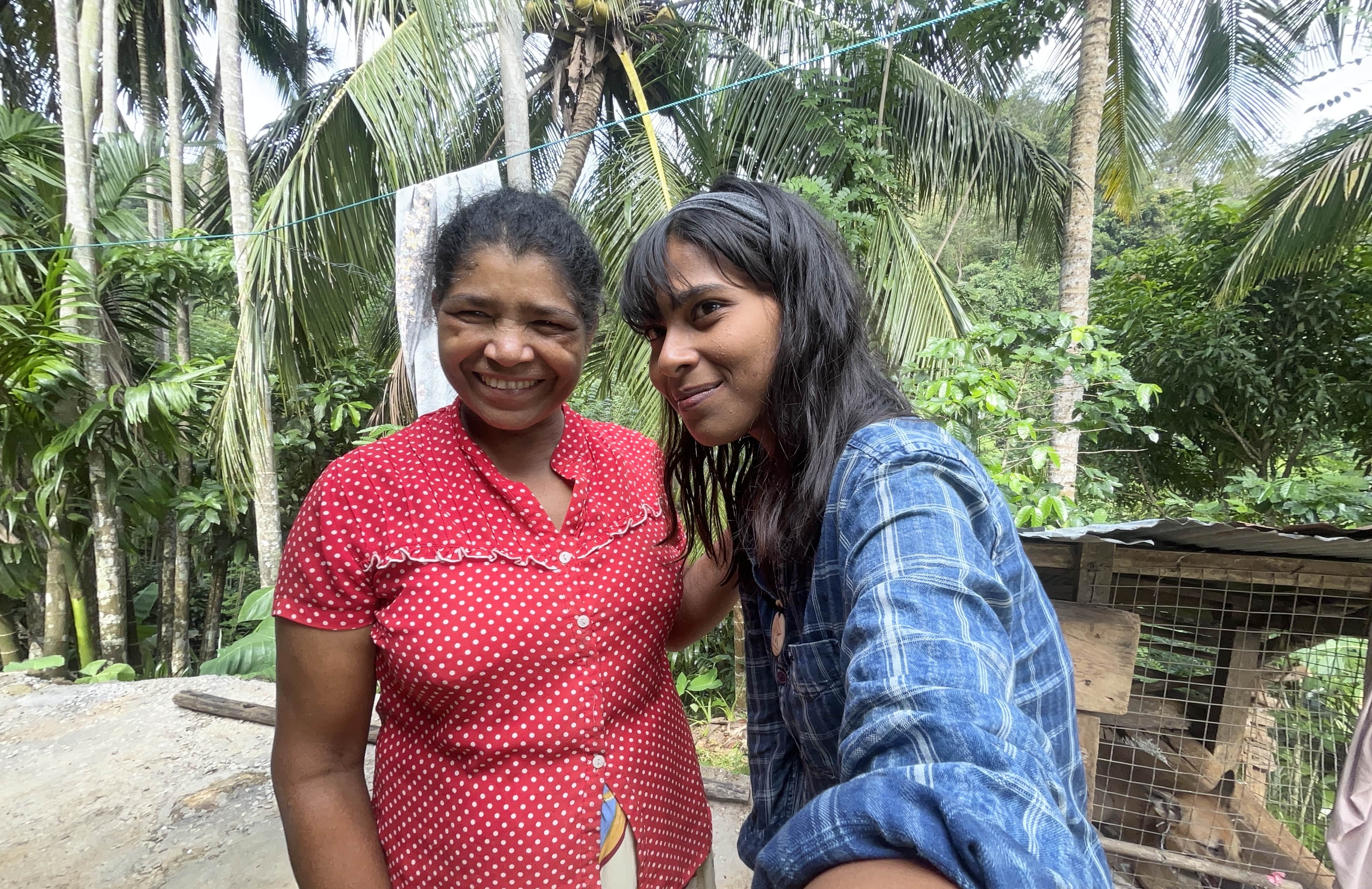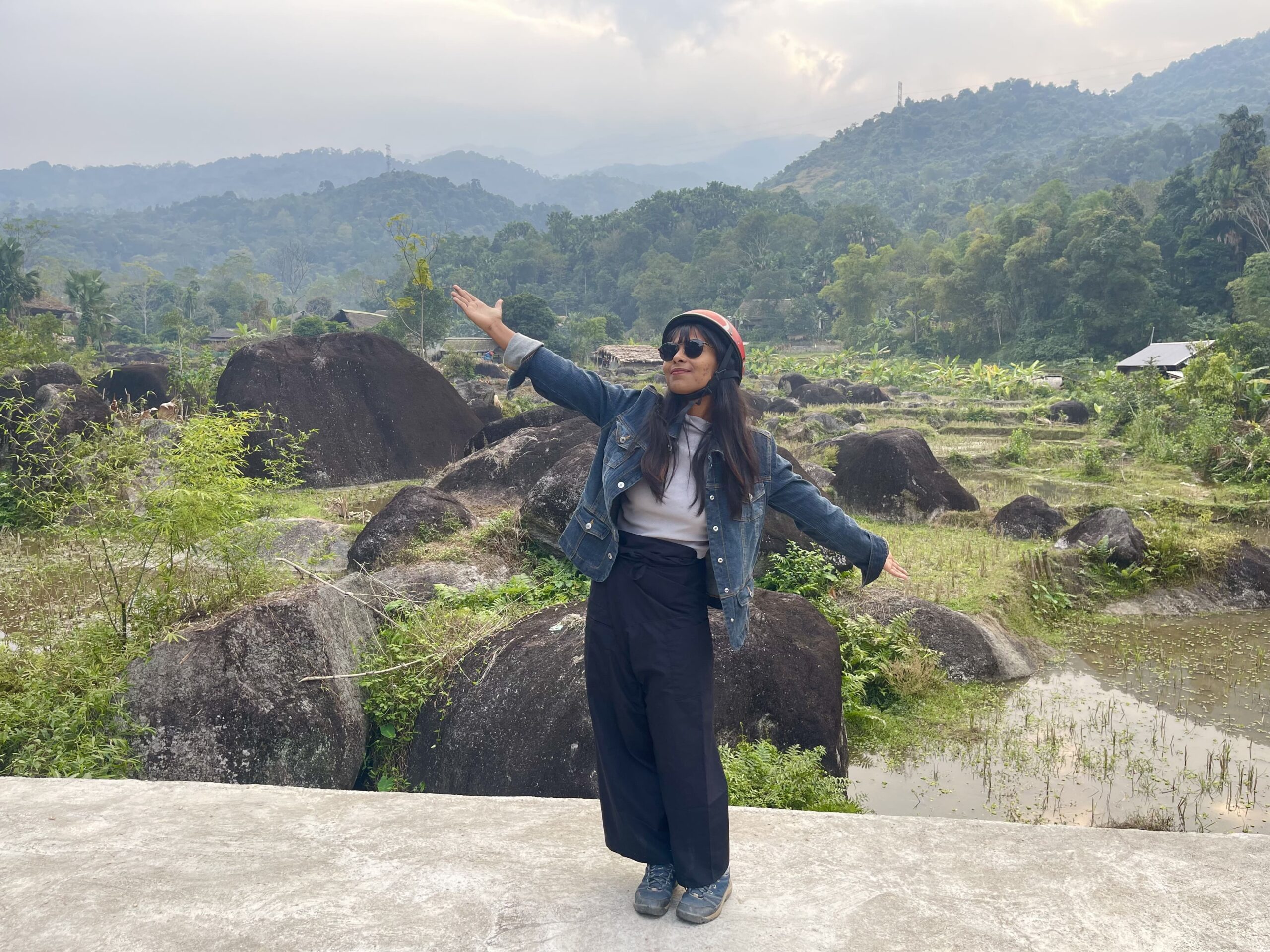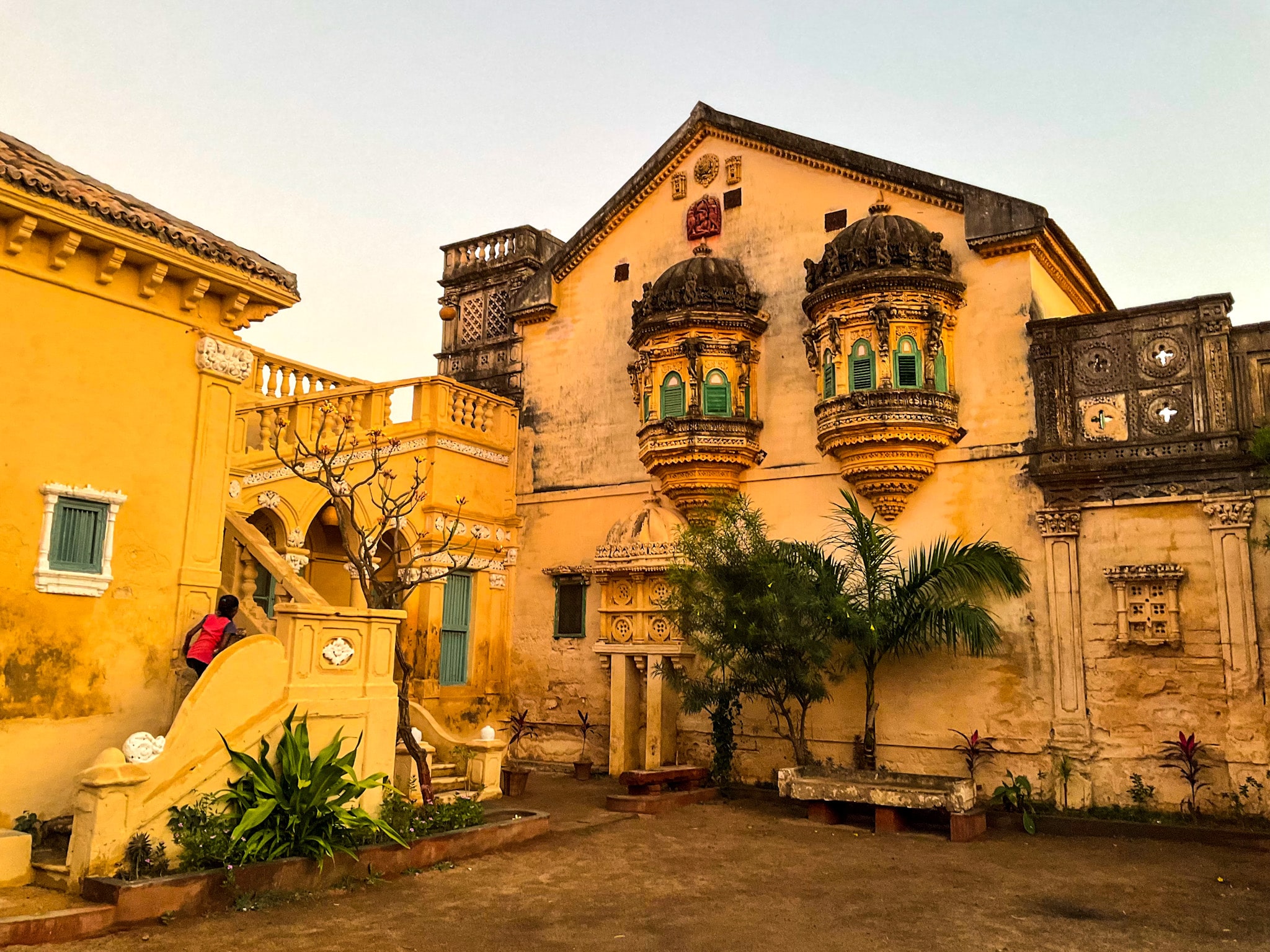Learning about the culture of Chamba, as I hiked for two days from Dalhousie to Jot through bear-jungles and set up camp in a village near Khajjiar. Here is a curious glimpse at the rural culture of Chamba in Himachal Pradesh.
‘Bhaiyaa, is this the way to Jot?’
‘There is a green board ‘Himachal Pradesh Forest Department’. Is that the right path?’
The fear of bears tucks into my guts, from left, right, and the rightmost corner… I forget to look up. Bears tend to climb the sturdy and muscular pine and deodar trees, and their prey-tactics hardly follow the survival manual. But as the experts have said, getting hit by a car is way more probable than being attacked by a bear.

The night-stay at Pohlani Mata Temple in Chamba awoke me to the Manimahesh Kailash Peak dissolved behind the meek sheet of a dubious colour that has no name. There is a colour, but I don’t see it. The orange of the sunset is gone. It’s an ordinary sight now, without a peak of the Peak. The temple glistens in a lousy red, billows out the tingling vibration of bells the devotees ring, out of habit, or by the familiarity of societal customs. To some, it’s a hike; to some, it’s reaching God. And to some, a mode of livelihood.
It was still extraordinary.
Pohlani Mata is an incarnation of Goddess Kali. Mythologically, some demons were harassing the local villagers of Chamba. The Goddess slayed them and established herself on the mountaintop as the primary deity.
I was still full from yesterday’s Bhandara – the Himachali feast at the temple, more like a Dham. Somebody was sponsoring the grand feast for 200 people who came from near and far villages to celebrate, in eating, drinking local alcohol (the men), and dancing.

I walk around the grassland aimlessly, to elude the morning conversations. ‘You can stay here for a week if you want. You don’t have to pay anything’. Rinku Verma watches me in a stuttered emptiness. He sells tea and Maggi just outside the temple and is the most trusting man around here. I move along, mornings are meant to forget words.
‘I would’ve loved to, really, but there is no Internet here, which was fine for a day. But I have to work’. I pee behind the loose rock that hid the backside of the temple from my sight, balancing me on the slope’s other slope. My eyes remain fixated on the parallel trail, while the urine makes a pool that will evaporate in heat, or in rain and vain.
Kasrod, Fafru, Ghandoli, Gucchi – these ‘janglee saags’ mashed with their cuisine with the growing inability to afford the market-veggies. Choli ki Saag, mixed with Chaach – a healthy household-meal, abundant in nature.
I buckle up my backpack. It tilts to one side, to spread out its weight on both shoulders within a moment, and settles around my waist, more like an embrace. An embrace that doesn’t wear thin. It feels a part of me.
Fear rules in ‘wildlife’, the formidable fear of what lies behind the bushes, the dread of an ambush, unseen, imperceptible. Nothing gets my heart pumping, like a rat in a race; nothing but the uncalculated apprehension of bumping against wildlife in Chamba.
Also read – Dalhousie with its Hailstorms And Dainkund Peak
Dainkund to Jot – Hiking the Bear-Trail Alone in Chamba

The conversation should not stop. In a survival manual, I had read about how connecting it is to have a direct conversation with the invisible bears, the trees that somehow all manage to look like bears. Senses are too strong; too compelling to bear. ‘Hello, Bear!’ I greet, almost on an auto-pilot. Fear invades every other cell, yet there is a wee release of respect. ‘Hello, Bear! I am an outsider, and I am just passing by’, followed by, ‘Don’t hurt me!’
Dry leaves make soft swishing sounds. Some patches hush their voice down, swimming into deeper crevices, stirring the needle-like fear that is boiling at 55° inside my belly. A fish making bubbles in my blood vessels!
Something moves. No, luck hasn’t run out.
Being the only hiker on a three-hour-long Bear Trail has an authenticity. The daunting green board of ‘The Himachal Pradesh Forest Department’ informs me of Mohani Dhar, but gives me no indication of Jot. Am I on the right trail?

The shepherds live in thatched huts, one or two families, with their goats and cows. ‘Bhaiyaa, am I on the right way to Jot?’ I shouted to the shepherds from the upper trail. ‘Yes!’ ‘Are there bears?’ ‘They generally don’t come out during the day.’ Yeah, everything hangs on a ‘generally’, the lives of these lives.
Twice the confusion bolted. Abandoned huts did not shout back. I held onto the trail, till the first limbs and the last homestay in the Chamba village named Jot.
Also read – A Tiny Space in the Ever-Growing Tourism in McLeodganj
Culture of Chamba – Veggies and the People

Indian Cedar, or Deoder, the state tree of Himachal, touches the sky-heaven, with their long-and-strong arms, so condensed that they erase every road and every house from the vision of the opposite mountain.
‘The epithet ‘Deodara’ is derived from Sanskrit ‘Devadaru’, meaning ‘tree of the gods’ or ‘timber-of-the-Gods’. The male and female cones are different. It is the strongest Indian coniferous wood owing to its antifungal, insect-repellent, and anti-bacterial properties. The bark is astringent and useful for fevers, diarrhea, and Dysentery. The oleoresin of Deodar and the dark-coloured oil extracted from the wood are valued as an application for ulcers and skin diseases.’ I read out from the tourist board of the Jot Nature Park, before the bus takes me to Khajjiar, the ‘Mini Switzerland of India’, I mean, is it?
My disappointment in Khajjiar collided with the receding waterbody unnoticed on an expansive field, only noticing the figureheads, herds of families, and the array of cars parked on the adjoining road. The hotch-potch.

The Pradhan of a close-by Chamba village hitched me on a ride with his companion, not before the police officer demanded an online copy of my Aadhar card. Yes, I will be camping at my own risk, in a bear-prone area. The risk-branch, however feeble and self-effacing it may be, bent to treasured lives without convocation. The people I fell in love with! A family in village Padhrottu; the mother, the father, two daughters, the cows Ganga and Bindo, the sheep Dhikloo and Khinu, the horse Lucky, and the goat.
‘Why didn’t you name the goat?’ The white body with careless black hair strands between blunt horns, posing like an all-knowing old lady.
‘He is new.’ He had already escaped death once, by sheer luck, or what they call ‘the rejection of the deity’. When a Goddess possesses the body of a human, the mediator or ‘Chela’, speaks on her behalf. In Chamba culture, they pour water on the goat in line for the sacral sacrifice. If the goat doesn’t shiver, it means the Goddess doesn’t want the offering, and the goat would be excused.
The Chela muttered, ‘I don’t want any goats now. I am satisfied. I will come back after four months and take it.’ And that decided the life of the goat. Or the living.

This horse-village has retained a long-livelihood of horse-riding around Khajjiar, a commercial ‘activity’ the tourists ‘enjoy’. The white horses pace up in a convoluted rhythm; khut-khut-khut-khut… Until the rider holds the motion, and my sleepy eyes open to a 19th-Texas feeling. Prince, Rohan, Lucky… Their names are etched around the neck.
Dolly’s father, a lifelong local of Chamba, was in the horse-riding business for years. Back then the father-mother used to guard their sleepy daughters’ heads with plastic covers in spilling rain all night long. The yawns claimed sleep, but the water wouldn’t mind a house that’s hardly a structure. What flows flows. The monsoons confiscate, what? They don’t have time to understand. They send their daughters to whoever is willing to provide shelter. To relatives, or a friend. The shame never leaves.
‘Every day I felt ashamed. I had to go to another house with excuses.’ Dolly, now counting 18 years in her saddle.
‘Tents are waterproof. The guests at the nearby campsite would let us share a tent, when things would get really bad. We would be sleeping that night’. The mother stirred Kasrod over the chula, the local vegetable that grows in the jungles of Chamba. Her pink bangles chime in affection. Kasrod, Fafru, Ghandoli, Gucchi – these ‘janglee saags’ mashed with their cuisine with the growing inability to afford the market-veggies. Choli ki Saag, mixed with Chaach – a healthy household-meal, abundant in nature. They never had to starve.

Kasrod goes in a long thin line, and forms a multi-layered circle on top, coiling like the leeches. Be it Chutney, or Sabzi, Kasrod makes a delectable pair with hot Phulkas.
Dolly plucks a leaf from a neighbour’s house and asks me to eat it raw. Khatora – sour and sweet. She points at Jaldru, the local remedy for cuts and bruises. I get distracted by a pitch-black cat with sapphire eyes, small with crouched legs. A sharp-horned cow runs past me by a fraction of inches, almost running me over.
Like all of the mountain areas, rhododendron decorates the forest, only they call it ‘Chew’, the edible flower of the Himalayas.
The old albums by the fireplace transport me to their extended family. The father‘s mother’s sister‘s youngest daughter… And her newborn baby… Kasrod cooks itself at the lowest temperature under the lid, over the hissed sound of the wood-burning. Dolly sweeps the kitchen floor with a broom made of baggar, a kind of grass they consider holy. That broom cannot be used anywhere but in the kitchen.
Also read – Connecting to Himachal through Village Kulthi in Tirthan Valley
Dham & the ‘Chela’ – The Himachali Culture

Dham, the community feast with a set menu, is primordial in the culture of Chamba, and includes Rice, Moong Dal, and Rajma Madra. This is followed by Boor ki Kari and Mash ki Dal, topped with Khatta, a spicy sauce. The dham ends with Mittha, the sweetened rice fused with lots of dry fruits and raisins.
In the Chamba culture, they pour water on the goat in line for the sacral sacrifice. If the goat doesn’t shiver, it means the Goddess doesn’t want the offering, and the goat would be excused.
A long garland hangs from the roof, to the length of the wall, touching the tip of the floor. The garland is to please Lord Shiva. Ancholi rings in, a homemade musical instrument with a plate or any utensil made of brass… The beats of Ancholi, Dholki, and Nagada kindle the chela to dance to his last breath. The local women join the beats with the slow tempo of their Natti.
Sickness either leads to jaributti (local herbs collected from the surroundings or from the ManiMahesh Yatra), or to the chela in temples. The mediator lights up a Dhuni and makes a sick person taste the dust as the dhuni dims down. And if sickness has come from a probable black-magic-induced food or drink, the sick person has to purify herself by putting her hands and feet in the water for hours.
Also read – Spiti Under My Feet – Walking Alone for 150 Km (9 Days)
Minjar Mela – The Harvest Festival of Chamba

Apart from the Sui Mata Festival, Minjar Mela, the harvest festival of Chamba, is a week-long carnival, held on the second Sunday of the Hindu month of Shravana. At the fair, the soulful and traditional Kunjari Malhar is sung by local artists. The festivities of the fair are celebrated at a place called ‘Chowgan’.
History speaks of the time when the King of Chamba was returning to the town after defeating the King of Trigarta, now known as Kangra, in 935 A.D. He was given a hearty welcome with bundles of paddy and maize. This was the beginning of Minjar Mela.
Traditionally, the fair is organised with the young paddy and the maize shoots cropping up from the soil. Minjar is a silk tassel worn on the front parts of a dress by men and women alike, marking the beginning of the festival. All over the busy town of Chamba, everyone wears the symbol of Minjar, which comprises a corn cob made of silk. Coconuts, or seasonal fruits, and a ‘Minjar’, composed of sheaves of paddy and golden silk wrapped in red fabric, are offered to God.
(You will find the annual dates for each year’s Minjar Mela here).
Camping for two nights anticipating the sounds of the forest had been a profound experience. And learning about their stories from their mouth made me more curious about the culture of Chamba.
Would You Camp in A Bear-Village Alone?
Support my solo adventures across the globe by joining the Patreon community!
Live the Adventure
Get weekly articles delivered to your doorstep and stay up-to-date with my new travel stories.





Leave a Reply